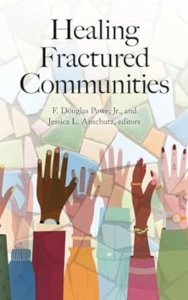Laura Heikes, pastor of a predominantly Anglo congregation in a Texas border town, shares how her congregation became more present to the people and culture of the surrounding community. Several small but strategic “acts of resistance” challenging dominant cultural norms were the first steps in a process of renewal aimed at transforming her church from a “rich white church” to a church that is truly for all.
My community is 95 percent Latino/a and 85 percent of the population speaks Spanish at home. Even at Walmart or the grocery store, I am often greeted in Spanish, although I have blonde hair and blue eyes. But the reality of my church could not have been more different. The faces I saw when I arrived were about 85-95 percent white. And the language? I had to hunt around to find bilingual folks. My people were moving in limited circles, remaining among the small group of people like them in culture and language.
It is my job as a pastor, not just to get to know my church and share God’s love with them, but to get to know my community so they can also hear about God’s love. I had to help my people know their neighbors. I had to help them make one meaningful connection to their community.
Our church’s transformation began with resistance, strategic, quiet, resistance to “the way we’ve always done things.” Resistance does not have to be loud or in-your-face. Resistance can be quiet. Resistance can be patient. Resistance can be strategic. I began to resist in ways people often did not even notice.
Coffee or agua fresca?
For example, when someone wants to meet for coffee on a hot day (and it usually is in South Texas), I will suggest we grab an agua fresca instead. Aguas are a delicious blend of fresh fruit, water, and sugar. And they have a taste Anglos enjoy. Best of all, my favorite agua stand has a location north of our church! Strategic resistance is turning a coffee date into an agua date! It also works well with lunch. I have a growing list of restaurants with amazing food where we need to order in Spanish. I get there early and translate, which eases the discomfort. We eat, talk, and quietly enjoy the culture.
I have found that eating at local businesses instead of chains is a culturally eye-opening experience that quietly increases cultural literacy and curiosity and can give the person a small sense of accomplishment that leads to greater engagement. Resistance, for me, is quiet, strategic, and as easy as suggesting meeting sites that helped my members and leaders engage with their community.
Adding bilingual staff
Another aspect of strategic resistance happens in hiring. In my first year, I suggested we add “bilingual preferred” to the job qualifications. There was pushback. One committee chair dismissed the idea, saying, “We decided a long time ago that we were an ‘English-only’ church.” “Hmmm,” I said, “but wouldn’t it be great if we found an amazing candidate who also spoke Spanish? Then, we would be ready if we needed that.” Another member chimed in. “I guess it wouldn’t cost us anything to add it.” The group, including the reluctant chair, saw the wisdom of this “cost-neutral” addition. Ever since, we have included “bilingual preferred” in job postings.
Now, three years in, half of the church staff are bilingual, and a majority are people of color. If you walk into our church office, you are just as likely to hear conversations in Spanish as in English. In just three years, the makeup of leadership has changed. Lovett Weems says that people “hear what they see.” There are quiet, strategic ways to help them “hear” diversity just by seeing the folks who are in leadership.
Diversifying congregational leaders
For that reason, we have also diversified our lay leadership, both in committees and on Sunday morning. If we are choosing lay readers or hosting Ash Wednesday along the roadside or selecting pictures for the stewardship letter, we include folks who reflect the diversity we are working towards. The pictures my church sees in the newsletter or on the screen on Sunday reflect not the current reality but the hope. It is a real hope, grounded in who is actually here, but focused on a future in which we will more fully reflect our community. Small, strategic resistance can have a profound impact. Who you hire, who you lift up in leadership, either confirms the existing culture of your church or helps it grow in a new direction.
Best of all, we are seeing fruit from these small means of resistance. The leader of the Women’s Ministry admitted to me that she “wasn’t really sure about our mission statement being in English and Spanish.” But as she went with us into the community for lunch, then to serve, and especially as she saw a more diverse group of people becoming involved, she had a change of heart. She became passionate about helping our members know their culture, and she dreamed up a Spanish class where folks like her could learn basic words and phrases. Fifteen people signed up, and 30 came! The class was so popular, it had to move to a bigger room. Instead of ending after four weeks, it kept going for eight weeks because everyone was so engaged! This year, for the first time ever, the choir picked a song in Spanish as an offertory! And when a member recently gave funds to place our mission statement above the entry doors, he said, “Let’s make sure it’s in English and Spanish so everyone can read it.”
Resistance, for me, has been quiet, strategic, and ongoing. That quiet resistance has been deeply transformational. The more the lay leadership of your church knows how to engage the community and the more your staff reflect the surrounding culture, the more your church will, too.
 From “Who is My Neighbor” by Laura Heikes in Healing Fractured Communities (Palmetto Publishing, 2024) edited by F. Douglas Powe Jr. and Jessica Anschutz. The book is available at the Lewis Center store and Amazon.
From “Who is My Neighbor” by Laura Heikes in Healing Fractured Communities (Palmetto Publishing, 2024) edited by F. Douglas Powe Jr. and Jessica Anschutz. The book is available at the Lewis Center store and Amazon.
Related Resources
- Healing Fractured Communities featuring Doug Powe and Jessica Anschutz — Leading Ideas Talks podcast episode | Podcast video | In-depth interview
- Being a Missionary in Your Own Community featuring Laura Heikes — Leading Ideas Talks podcast episode | Podcast transcript
- All Leadership is Cross-Cultural Leadership, a Leading Voices video featuring Laura Heikes
Image by Freepik






